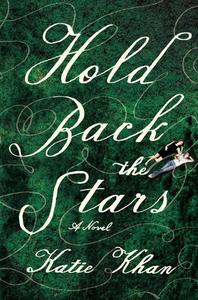
|
|
| photo: Don Wood | |
Katie Khan works for a film studio in the U.K. and is a graduate of the Faber Academy writing course. Hold Back the Stars (just published by Gallery Books, reviewed below) is her debut novel.
Hold Back the Stars is set in a utopian Europe, caught between the wastelands of the United States and the Middle East, both devastated by nuclear war. What gave you the idea to create this world for your love story?
As a reader, I find myself most engaged, and most likely to be heartbroken, when a character is in complete conflict with their environment. I adore stories that have a huge, sweeping backdrop, such as novels set during the war, like All the Light We Cannot See by Anthony Doerr and Atonement by Ian McEwan. I love fantasy and speculative fiction. too, things like Philip K. Dick's short stories and 1984 by George Orwell. I also read a lot of young adult novels--my favorites are His Dark Materials by Philip Pullman and The Knife of Never Letting Go by Patrick Ness--and likewise I think those stories have small characters struggling against a world much bigger than them, full of dramatic landscapes and political machinations. I found it fascinating that all of these, my favorite books, feature love and romance in a way that feels fresh and not too "schlocky," which is why I set out to show Max and Carys's relationship as a very human connection, and something worth fighting for.
The framing story of Hold Back the Stars features Carys and Max, two lovers trapped in space with just 90 minutes of oxygen left. Did the movie Gravity inspire this?
I had written around 10,000 words of Hold Back the Stars during the Faber Academy novel-writing course when I saw the first trailer for the film Gravity. I was so surprised! So many of the elements were there. Terrified, I charmed my way into the first screening of Gravity in the U.K., so I could see just how similar it might be to my novel and if I'd have to change or abandon the idea entirely. I'd already planned that more than half of Hold Back the Stars was going to take place on Earth, and I knew that it wasn't quite our current world, but a near-future version of Earth. These elements made it feel incredibly different, so I carried on with the writing and finished the story.
As well as being a novelist I also work for a film studio, and I think reading scripts and working with visuals all day has indelibly left its mark on my writing style. When I imagine a scene, one of the first things I think about is what the standout visual will be. What will the whole thing look like? As I piece together a plot, I remember it as a chain of visuals: a light-up dance floor, an abandoned observatory, a great hall inspired by the political auditoriums of Star Wars or The Hunger Games. I also think the dialogue in brilliant screenplays can be really exciting to read, as well as watch, and I strived to make Carys and Max talk to each other in a way that felt alive and heartfelt--and funny, where possible--particularly when they were set against a stark, dark vacuum.
Was balancing the juxtaposition between Carys and Max's present day in space and their past in Europia tricky? How did you decide how much of each story to tell?
I wrote the opening scene with Carys and Max discovering they had only 90 minutes of air remaining, then immediately wrote a scene on Earth showing their first meeting. From there, I knew the story would alternate between Earth and space, with an overarching "hairpin" shape with the two timelines moving towards each other before converging. I worked hard to make sure I wasn't pulling the reader out of a timeline they were enjoying and plunging them, cold, into the other; I was so inspired by the opening chapter of Revolutionary Road, where the author Richard Yates throws us back to a long-term couple's first meeting so elegantly that I re-read the scene multiple times to spot where and how he did it.
The most important thing, for me, was to make sure the stories were connected in a more fundamental way than just featuring the same characters: I wanted the reason Carys and Max were in space to connect with the relationship being played out on Earth.  In Europia, people live "on Rotation," moving "Voivodes" (a futuristic, multicultural city) every three years. What made you settle on this model, and on the word Voivode?
In Europia, people live "on Rotation," moving "Voivodes" (a futuristic, multicultural city) every three years. What made you settle on this model, and on the word Voivode?
To imagine a European utopia, I drew up a list of cultural changes that would have to take place in the world for a utopia to work. Not only was I sure that something cataclysmic would have to happen (for example, a nuclear war) for society to accept such a radical departure from our way of life, but somewhere along the way, I decided that anything that can divide and mark us as different from one another, like national identity, would have to go. For European residents to no longer feel "British" or "French," I developed the idea that residents would live in mixed, multicultural cities for three years, before moving into different communities on their next "Rotation." As such, I wanted a new, catch-all word for countries and regions, away from their current identities, and having read a lot about the evolution of Europe, I hit upon an ancient Eastern European expression ("voivode") for independently ruled districts.
Hold Back the Stars also refers to a lot of futuristic technology--in everything from birth control methods to AI interfaces. Did you do a lot of research to create such science accurately?
Part of the fun of creating a future world is looking at what we do now and imagining how it might evolve over the next few hundred years, even if they're only subtle changes. I wanted to write a world we still recognize as ours, and I relished looking at our current homes where many of us have laptops, televisions and smartphones, and imagining instead turning the walls of our rooms over to be large screens ("Wall Rivers") instead. For the physics of space, I naturally had to fictionalize some of the science used; there is a scene involving red oxygen (which does currently exist) and black oxygen (which does not).
Both NASA and the ESA have incredible online resources. There's the photos they take from the International Space Station and their astronauts blog their training experiences, so I mined them to get the right feel. Google has an index of patents, so I read through the designs of patent-pending spacesuits to help imagine what they might be like in the future. However, I did want any science to be handled with a light touch and always to remain secondary to the human emotion and characters.
One of the characters ends up getting a dog named Laika, like the Soviet space dog. According to your Twitter bio, you are a dog lover. Was Laika inspired by a dog you have owned?
It was lovely to write a rescue dog into the story, because my family has a rescue called Poppy and she is the most wonderful dog you can imagine--very loyal and affectionate. I felt strongly that a character who needed to be brought back from the edge of grief would be helped by a relationship with a terribly loving rescue dog.
Can you tell us what you're working on next?
I'm working on two further standalone novels which, like Hold Back the Stars, feature a love story of sorts with a genre twist. The next uses time travel, which is great fun to write, but needs a lot of plotting with a strict timeline! --Jessica Howard, blogger at Quirky Bookworm

